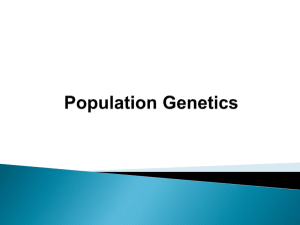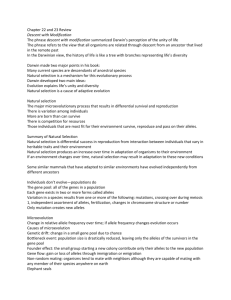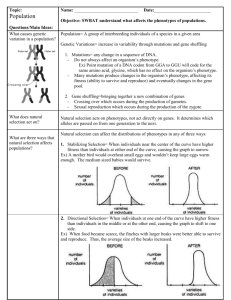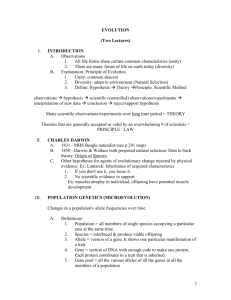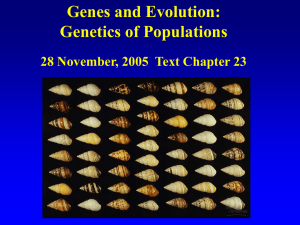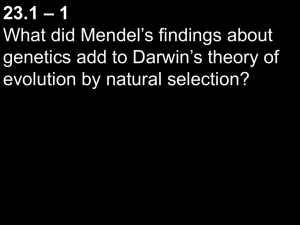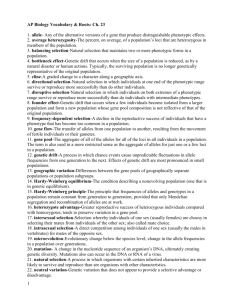Outline - Mrs. Iufer
advertisement
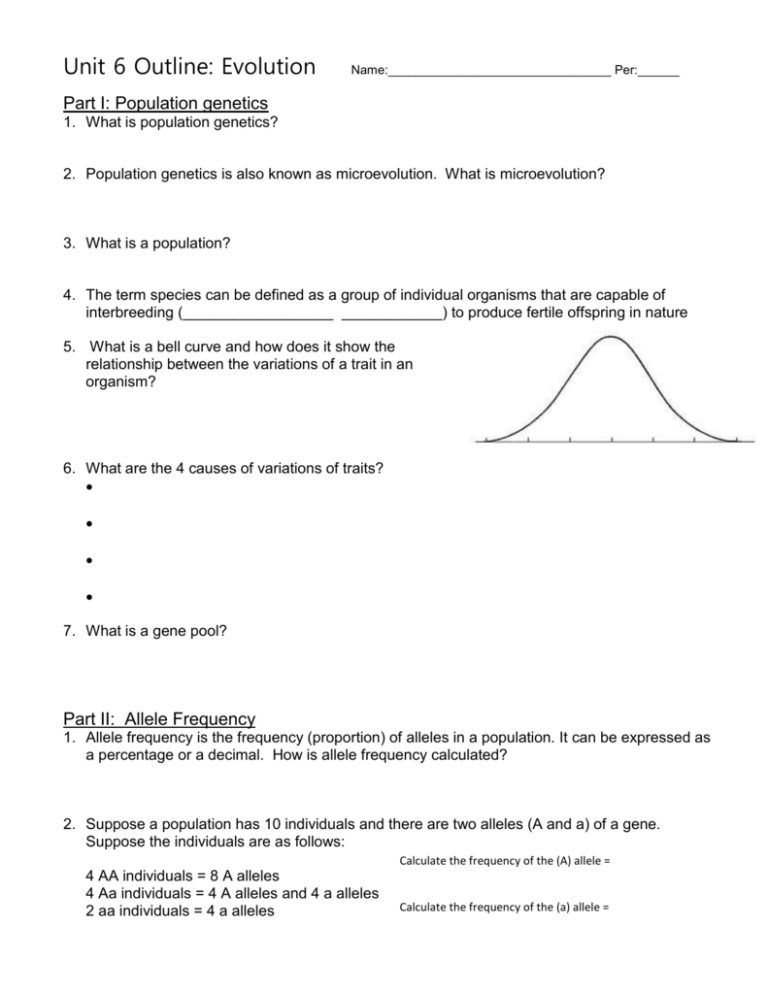
Unit 6 Outline: Evolution Name:________________________________ Per:______ Part I: Population genetics 1. What is population genetics? 2. Population genetics is also known as microevolution. What is microevolution? 3. What is a population? 4. The term species can be defined as a group of individual organisms that are capable of interbreeding (__________________ ____________) to produce fertile offspring in nature 5. What is a bell curve and how does it show the relationship between the variations of a trait in an organism? 6. What are the 4 causes of variations of traits? 7. What is a gene pool? Part II: Allele Frequency 1. Allele frequency is the frequency (proportion) of alleles in a population. It can be expressed as a percentage or a decimal. How is allele frequency calculated? 2. Suppose a population has 10 individuals and there are two alleles (A and a) of a gene. Suppose the individuals are as follows: Calculate the frequency of the (A) allele = 4 AA individuals = 8 A alleles 4 Aa individuals = 4 A alleles and 4 a alleles 2 aa individuals = 4 a alleles Calculate the frequency of the (a) allele = 3. The allele frequencies in a population will remain the same from generation to generation unless acted upon by outside forces; this is known as the Hardy-Weinberg genetic equilibrium. It describes the “situation” under which evolution will not occur. This principle is based on a set of five assumptions. What are these assumptions? 4. What is an adaptation? Give an example. 5. What is acclimation (acquired trait)? Give an example. Part III: Disruption of Genetic Equilibrium In this section we are going to focus on the external forces that can change the allele frequencies and lead to EVOLUTION! Populations Can Evolve Through Gene Mutation Gene Flow Non-random Mating (Sexual selection) Genetic Drift Natural Selection 1. What is a mutation and how can mutations result in evolution occurring? 2. What is the difference between immigration and emigration? 3. How does immigration and emigration affect the numbers of a population and its gene pool? How does this relate to the gene flow of a population? 4. What is genetic drift? Why does this occur? 5. Why is random mating so important to keeping a gene pool stable? 6. Compare sexual selection to artificial selection. Give an example of each. Part IV: Types of Natural Selection 1. What is natural selection? 2. Natural Selection occurs due to variations of traits that give specific organisms an advantage (ex: body size, body color, etc.). When natural selection is at work over time, the distribution of traits in the population may change (ex: small, medium and large body size; light, medium and dark body color; etc.). You would see this as a shift away from the normal bell curve. Scientists observe three general patterns of natural selection. Describe each and give an example. a. Directional Selection Normal bell curve →Shifting away from bell curve b. Stabilizing Selection c. Disruptive Selection 3. Label the distribution curves below as Stabilizing, Directional or Disruptive Selection. = original population (before selection) = population after selection _______________ Selection _______________ Selection _______________ Selection Part V: Formation of a species & Evolution in Action 1. Define speciation. 2. Classifying organisms according to their internal and external structure and appearance is known as ________________________. Give an example. 3. What is the biological species concept? 4. New species can arise from ________________________________ isolation, in which members of a population are physically separated. Give an example. 5. Describe reproductive isolation. Describe the difference between prezygotic and postzygotic isolation. Give examples of each. 6. What is convergent evolution? 7. What is divergent evolution? 8. What is coevolution? Part VI: History of Evolutionary Thought 1. Who was Jean Baptiste de Lamarck and how did he influence the theory of evolution? What was the main idea behind his theory? Why was he wrong? 2. What hypothesis did Charles Darwin and Alfred Wallace both propose in the mid-1800’s? 3. What is Darwin’s idea of Descent with Modification? 4. Darwin proposed the theory of Natural Selection as the mechanism (or method) for decent with modification. Explain his idea of Modification by Natural Selection. 5. What is genetic variation? How does it relate to evolution by natural selection? 6. What is evolutionary fitness? Part VII: Patterns and Evidence of Evolution 1. List the 4 types of evidence for evolution. 2. What is a fossil? 3. Explain how most fossils are formed. 4. What is the law of superposition? Compare fossil X and Z in the image to the right. X 5. How is a fossil’s absolute age determined? Z 6. What is a transitional species? How do transitional species support the theory of Evolution? Give an example. 7. Scientists often use anatomical similarities and differences to map out the evolution of a species. Describe the difference between homologous, analogous, and vestigial structures. Give an example of each. a. Homologous structures b. Analogous structures c. Vestigial structures 8. How can the embryology of an organism help with determining the evolution of a species? 9. How can biological molecules be used to help determine relationships between different species (molecular clocks)? Give an example.
